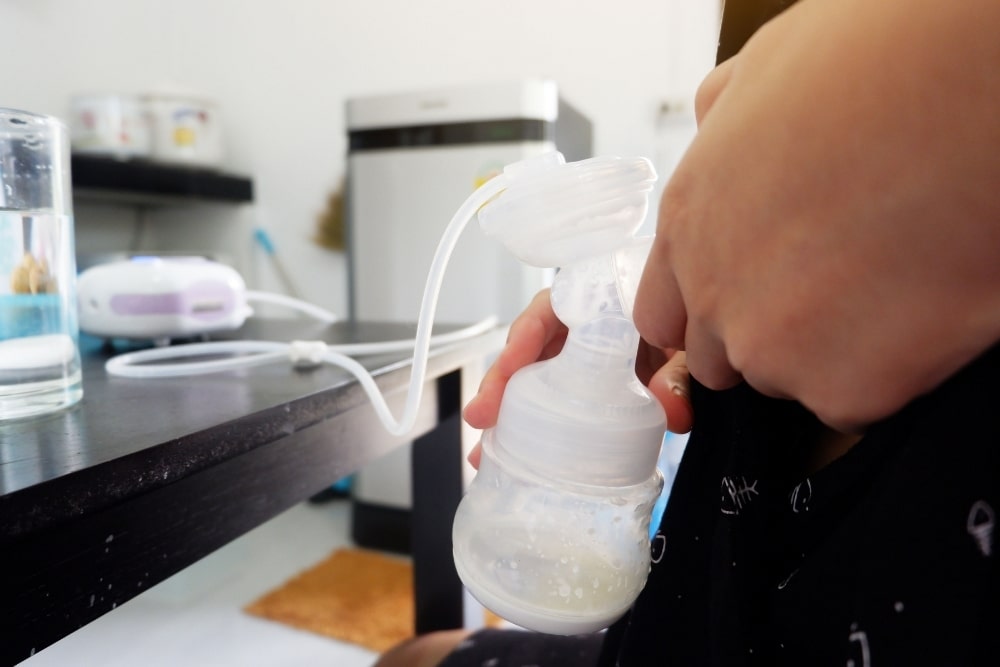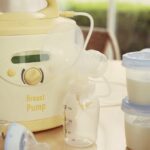Leaving your baby while you head off to work is one of the hardest parts of returning to work. You miss them and worry about them. Among other things, you’re bound to worry about whether they’ll have enough breastmilk while you’re gone.
I remember my nephew wailing because he had to wait for his mom to get home on lunch to eat. No one wants to be in that situation, especially a mom.
Nothing compares to the mom guilt you feel in that situation. This guide is going to help you prevent just that. When you make sure that you store at least enough for 3-4 days before heading back to the office.
Storing Breastmilk Before Going Back To Work
- SMART STORAGE: Perfect for storing all of babys mealtime needs; Breast milk, formula, food, snacks, drinks, juice boxes, pudding, yogurt, and fruit snacks are organized and in their place; Perfect for feeding accessories - bottles, sippy cups, lids, spoons, forks, cups, dishes and more are always in easy reach and ready to carry to the table; Great for fridge, freezer, cabinet, and pantry; Non-skid feet allow bins to stack and take advantage of vertical storage space; Set of 2
Prices pulled from the Amazon Product Advertising API on:
Product prices and availability are accurate as of the date/time indicated and are subject to change. Any price and availability information displayed on [relevant Amazon Site(s), as applicable] at the time of purchase will apply to the purchase of this product.
Some people try to store as much as possible. That’s not necessary. You only need 3-4 days worth of milk. This is because you’ll more than likely be pumping during work, such as on lunch breaks. This will keep you with a steady supply.
Determine How Much Milk You Need For Four Days
This can be the tricky part because you aren’t measuring breastmilk before your baby drinks it unless you’re feeding your little one breastmilk from a bottle.
In that situation, you’ll simply make a mental note of how many feedings there are going to be while you’re at work.
Don’t forget to include the time it takes to commute back and forth to work. Then, multiply that number by the number of ounces your baby drinks at each feeding.
Those of you that aren’t giving your baby breastmilk out of a bottle can still determine how much your baby eats by using a baby scale. A baby scale will weigh your little one in ounces.
First, weigh your baby before eating. Then, weigh them again after feeding. The number of ounces that they gained is how many ounces they eat per feeding.
Once you determine how much milk you’ll need for four days, multiple that by four. That will tell you how much breastmilk you’ll need to have in the freezer before heading back to work.
Double Check The Milk For High Lipase After Freezing And Thawing It
Some people have a higher amount of lipase than other people. You and your baby might not notice this during breastfeeding from the breast.
However, once the milk is frozen, this causes the fat to separate from the milk. It results in a different taste and smell for babies. Symptoms of high lipase include a different smell and taste.
In the beginning, breastmilk will smell a bit soapy. Then, it may smell sour, as if the milk has gone bad even though it hasn’t.
Most people notice this after the milk has sat out for a tiny bit or takes longer to freeze. This is because as the milk sits out, the high lipase content causes the fats to break down quicker than they normally would. You can also thaw out the first bit of stored breast milk and smell it to determine if this is going to be a problem.
Freeze Breastmilk With High Lipase As Soon As Possible
If you find out that it is, there are a couple of things you can do to make sure that you have stored breastmilk that your baby will drink. First, consider pumping milk directly into storage bags.
Then, immediately put it into the freezer. Most freezers get colder in the back of the freezer, making this the perfect location to put freshly pumped breastmilk.
The faster it freezes, the less of a reaction there will be. Your milk should still smell and taste fresh once thawed out.
Freeze Breastmilk In Smaller Quantities If You Have High Lipase
Make sure that you separate milk into storage bags that are just enough for one bottle if you have high lipase in your breastmilk. Remember, once the milk sits out the reaction starts, even if it’s in the refrigerator.
If you try to store gallons at a time, whoever is watching your baby will wind up with a gallon of breastmilk that your baby might not drink.
How To Build Up A Stash Of Breastmilk
- Pain Free & Fast Sucking - 2 Mode (pumping mode and massage mode), 9 levels for each mode. Massage mode helps to push the milk out of your milk ducts and reduce the discomfort of the breasts; 9 suction levels ensures every mom find her own rhythm and produce more milk in less time.
Prices pulled from the Amazon Product Advertising API on:
Product prices and availability are accurate as of the date/time indicated and are subject to change. Any price and availability information displayed on [relevant Amazon Site(s), as applicable] at the time of purchase will apply to the purchase of this product.
Once you realize how much breastmilk you need, you’ll also realize that you need a personal stockpile of it in your freezer to accommodate your little one for a few days.
It can seem like a daunting task, but it’s not. With these tips, you’ll find that it does not require as much effort as you think. It’s important to take it a little bit at a time.
Make Sure You’re Comfortable With Breast Pumping
If you’re used to feeding your baby straight from the breast, pumping milk can be a little uncomfortable at first. This is only because it’s something different.
Take some time to get used to your breast pump, and storing breastmilk in the freezer. There is a little bit of a learning curve, but you’ll be fine!
Start A Few Weeks Before Returning To Work
You’ll need to start about three weeks before returning to work. This is because your body will not suddenly produce enough milk to provide you with a stockpile overnight. Instead, you’ll have to store a little bit at a time.
Pump After Three Feedings Per Day
If you pump after each feeding, your body will start to produce a significantly larger amount of milk than you need. It can lead to painful engorgement when you’re at work.
You’ll also start to leak quite a bit. That’s why you only want to do this after three feedings a day.
Only Pump After Your Baby Nurses
When you pump before your baby nurses, the infant gets whatever is left. That might not be enough milk. However, if you pump after the baby is done nursing you’ll know that they are not hungry anymore.
After each feeding, you’ll more than likely find that you can only pump an extra 1-2 ounces. That’s okay. It’s why you’re starting three weeks before going back to work. You’ll have plenty by the time your maternity leave is over.
Keep Pumping While You’re At Work
View in gallery
You’ll need to keep the supply of breastmilk in the freezer up while you’re at work, too. Most moms pump on their lunch break or during breaks. Discuss this with your boss.
Most provide a little bit of leniency for breastfeeding mothers to pump when they need to. Don’t forget that you need to mark the date on the storage bags. Use the oldest breastmilk in the freezer first to make sure that you don’t accidentally waste any.
In Conclusion
When you’re planning to return to work after maternity leave, it’s important to plan ahead. It’s recommended to start your baby on a bottle 3-4 weeks before returning to work.
This gives you plenty of time to make adjustments as needed. For example, you’ll be able to try out different nipples if your baby refuses some shapes or materials.
You’ll also need to plan ahead when storing breastmilk. Consider starting at least 3 weeks in advance to give yourself plenty of time to build up a nice stockpile before returning to work.






